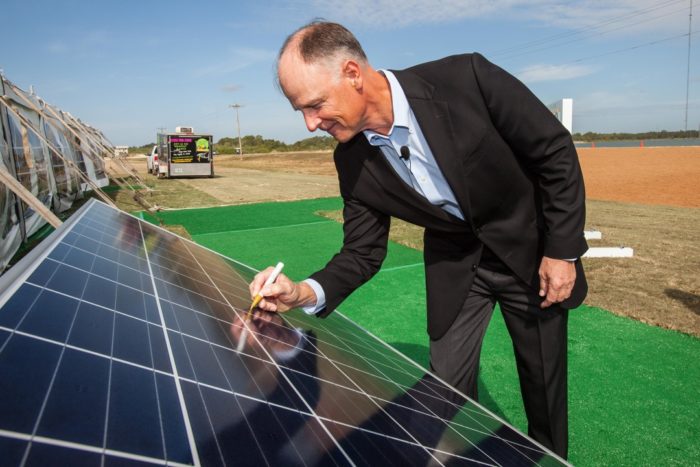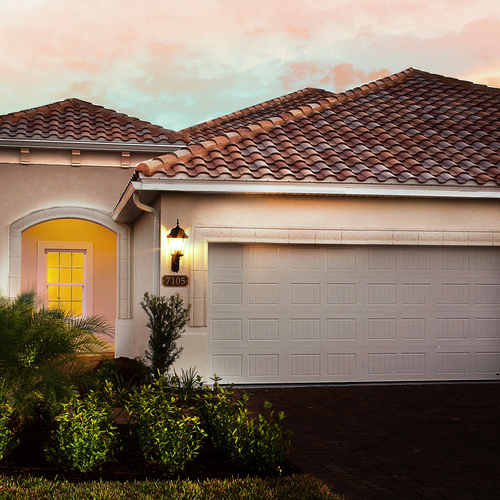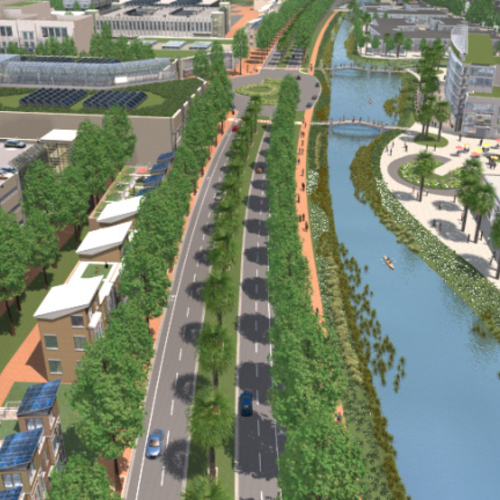Image Credit: All images: Babcock Ranch
Image Credit: All images: Babcock Ranch When completed, Babcock Ranch will include 19,500 residences and 6 million square feet of commercial space. The process could take up to 25 years. The development covers nearly 18,000 acres. Developers want a range of house styles and prices, an effort to build a community covering a wide swath of income and age levels. The first houses are due for completion next year.
Work is underway on Babcock Ranch, a new Florida community that will eventually include 19,500 single-family and multifamily homes on nearly 18,000 acres. The developers tout the project as the world’s “first solar-powered town,” calling it the “most sustainable” community in the U.S.
Babcock Ranch is named for a sprawling, family-owned cattle ranch that once occupied the site. It is the work of Kitson & Partners, a real estate developer based in Palm Beach Gardens, Florida. The company’s portfolio includes millions of square feet of retail shopping centers, commercial buildings, and residential projects. Babcock Ranch is its first venture into sustainable building.
Kitson bought the 91,000-acre ranch from the Babcock family in 2006. In a $350 million deal with the state of Florida and Lee County, 73,000 acres became a land preserve on which ranching operations could continue while Kitson pursued its development plans on the rest, according to a narrative at the development’s website.
Babcock Ranch is in the town of Punta Gorda, about 10 miles east of Fort Meyers on Florida’s Gulf Coast. The first 1,100 homes are due for completion next year. When complete, a process that could take as long as 25 years, the community will house some 50,000 people.
Babcock Ranch will be a built-from-scratch community emphasizing energy-efficient building, resource conservation, green spaces, renewable energy, and what Kitson calls “civitas,” which the company describes as a “basic hometown pride and a calling to participate and belong.”
Nation’s “first solar-powered town”
The community will be powered by a 74.5-megawatt photovoltaic (PV) facility being built by Florida Power and Light on 443 acres of land donated by Kitson & Partners CEO Syd Kitson. Due for completion later this year, it’s one of three new solar centers that FPL is building in the state.
In an interview with the website Ecopreneurist, Kitson said the 350,000 PV modules at the FPL Babcock Ranch Solar Energy Center will produce enough electricity to power a community of 50,000 people. “During the day when the sun is shining, all the power at Babcock Ranch will be solar energy,” he said. “Then at night when the sun goes down, the grid will take over and it will be natural gas. The combination of energy will be the greenest in the country.”
According to the report, Kitson is looking into the possibility of adding battery storage to the solar farm. “We’re talking to several companies about how we can do that, even at a neighborhood scale, almost like a micro-community of a system,” he said.
FPL says that it plans to bring 225 MW of PV capacity online this year, tripling the utility’s solar capacity.
Houses will be energy-efficient
Babcock Ranch will offer houses in a mix of architectural styles, which it said would include “Craftsman, farmhouse, coastal Gulf vernacular, Spanish, and colonial/West Indies … each sourced in the pre-World War II southwest Florida regional styles.”
The first phase of the project will include a mix of single-family and multifamily units in price ranges intended to be affordable, moderate, and luxury. Residents can choose to live near the town center or in more rural settings. The development hopes to attract all age groups, from millennials to retirees.
“We keep trying to remind people we’re building a town, not just a development, and we want to have the full stratification of prices because you’re not a real town if you don’t,” said Babcock Ranch spokeswoman Lisa Hall. She said prices would range from the $200,000s to the $900,000s.
No matter what the style, houses will be built to standards of the Florida Green Building Coalition. The building standard is similar in approach to the LEED for Homes program in that it sets a number of prerequisites and then offers points for complying with other measures that save energy, reduce water use, and preserve native ecology.
Energy raters must provide a HERS index rating showing better-than-code energy efficiency, with extra points awarded for a HERS score lower than 80. (A HERS index of 80 means the house uses 20% less energy than a house built to the 2004 International Energy Conservation Code.) Extra points are awarded for such things as completing the Energy Star Thermal Enclosure checklist, sealing ductwork with mastic, incorporating passive solar heat, shading the house with trees on east and west exposures, and keeping the washer and dryer in an unconditioned space.
Not a golf community
Hall said that developers believe the market has changed. According to Hall, instead of exclusive developments built around fancy golf courses, buyers are more interested in inclusive communities. So instead of building a golf course, Kitson is making an initial investment in the start of a downtown, with a K-8 charter school, a health and wellness center, and 50 miles of trails with trail-heads in each of the planned communities.
“What we’re really trying to do at Babcock Ranch is to bring green into the mainstream, and to bring it into the mainstream you can’t price it out of accessibility,” Hall said. “You have to choose a standard that makes sense for Florida. If you go to LEED Platinum, no one can afford to buy the homes, and you can’t get the builders to build homes no one can afford.
“By doing the utility-scale generation, that’s one way of bringing it into the mainstream, and by having the green build certification throughout the community you’re really raising the bar,” Hall continued. “At the same time, you’re not taking it to the point where people can’t afford it. Because it won’t be adopted if people can’t afford the homes.”
In addition to building its own water and wastewater utility, Babcock Ranch is adding a graywater system for all outdoor irrigation, and is limiting landscaping to mostly native species.
Half of Babcock Ranch’s total footprint will be dedicated to parks, lakes, and hiking trails.
Weekly Newsletter
Get building science and energy efficiency advice, plus special offers, in your inbox.














0 Comments
Log in or create an account to post a comment.
Sign up Log in